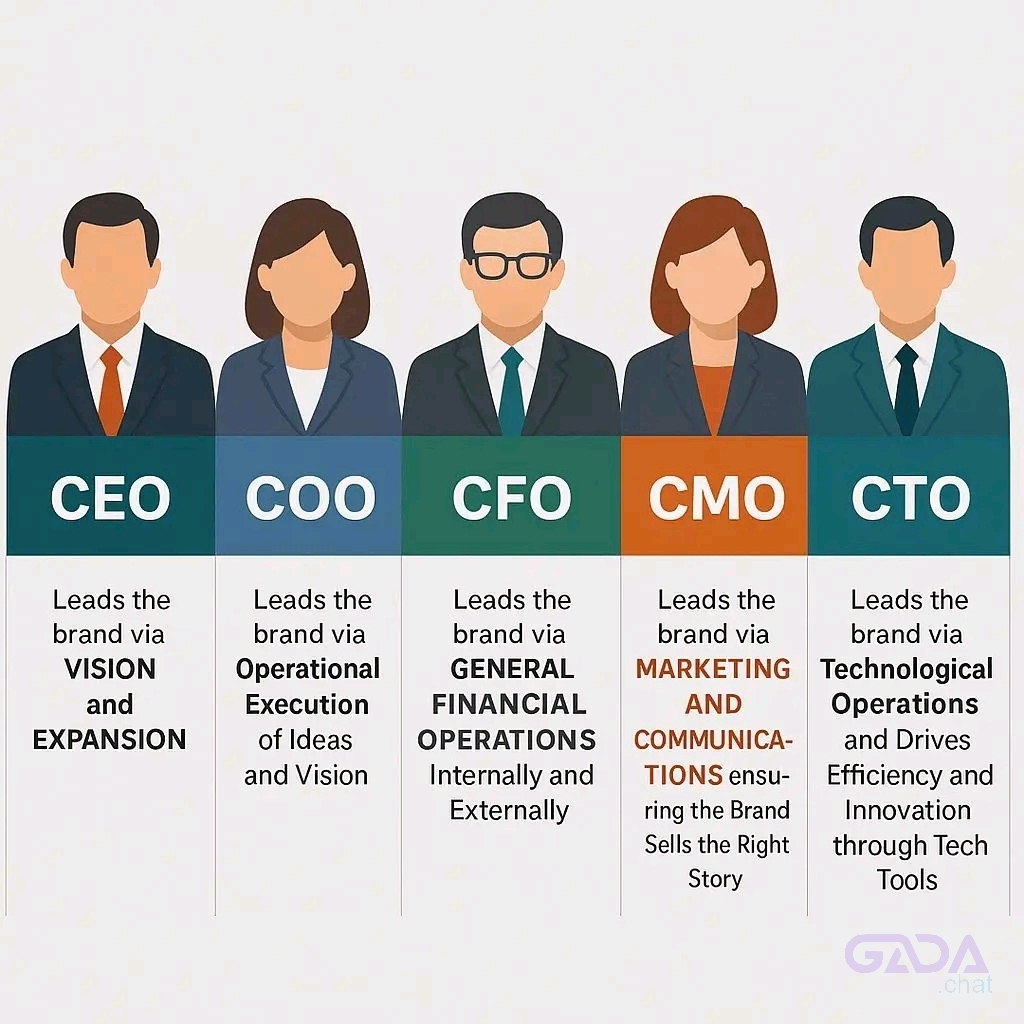Understanding the Full C-Suite:
CEO, COO, CFO, CMO AND CTO
1. Main Leadership Roles
CEO – Leads the company through vision and strategic direction
COO – Oversees daily operations and executes strategic plans
CFO – Manages all financial aspects, both internal and external
CMO – Drives marketing, brand storytelling, and communication
CTO – Oversees technological systems, innovation, and efficiency
.
2. On Strategic Vision
CEO – Sets and drives the overarching strategy and growth
COO – Implements the vision through effective operational execution
CFO – Ensures financial discipline and sustainability
CMO – Aligns marketing strategy with business vision
CTO – Aligns tech innovation with long-term strategic goals
.
3. Stakeholder Relations
CEO – Public face of the company, engages with top stakeholders
COO – Coordinates internal teams and departments for smooth delivery
CFO – Reports financials to the board and investors
CMO – Engages with customers and markets to build brand trust
CTO – Communicates tech strategy to internal teams and partners
.
4. Impact on Company’s Values & Benchmarks
CEO – Defines and champions corporate values
COO – Ensures processes align with company values
CFO – Sets and tracks financial benchmarks
CMO – Upholds brand values through campaigns
CTO – Embeds innovation and efficiency into company culture
.
.
5. Role in Market Strategy
CEO – Leads global expansion and long-term positioning
COO – Ensures seamless operations in target markets
CFO – Maximizes returns in existing markets
CMO – Penetrates markets through branding and promotions
CTO – Enables market reach through scalable tech solutions
.
.
6. Client Focus
CEO – Focuses on major partnerships and acquisition
COO – Enhances delivery and service quality
CFO – Drives retention via value-based pricing
CMO – Engages and retains clients through storytelling and loyalty
CTO – Improves client experience through technology
.
.
7. Risk Management
CEO – Sets the company’s risk appetite
COO – Mitigates execution risks
CFO – Manages financial and compliance risks
CMO – Guards brand reputation
CTO – Manages cybersecurity and tech-related risks
.
.
8. Relation to the Brand
CEO – Shapes and evolves the brand identity
COO – Maintains delivery consistency in line with brand promise
CFO – Evaluates brand performance metrics
CMO – Crafts and amplifies the brand story
CTO – Ensures the digital experience aligns with brand expectations
.
.
9. Role in Investments
CEO – Determines high-level investment strategy
COO – Allocates resources effectively
CFO – Manages investment portfolios
CMO – Invests in market positioning and brand assets
CTO – Invests in scalable and innovative tech infrastructure
.
.
10. Involvement in Product Lifecycle
CEO – Champions product innovation and market fit
COO – Manages production and delivery timelines
CFO – Assesses product profitability and ROI
CMO – Positions and promotes products in the market
CTO – Supports development, testing, and tech performance
Conclusion
A fully empowered C-Class Team is the backbone of every thriving global brand. Each executive plays a unique yet interconnected role in driving vision, execution, financial growth, brand excellence, and innovation. It’s exciting to know that we're getting there.
#highlightseveryone #highlights
CEO, COO, CFO, CMO AND CTO
1. Main Leadership Roles
CEO – Leads the company through vision and strategic direction
COO – Oversees daily operations and executes strategic plans
CFO – Manages all financial aspects, both internal and external
CMO – Drives marketing, brand storytelling, and communication
CTO – Oversees technological systems, innovation, and efficiency
.
2. On Strategic Vision
CEO – Sets and drives the overarching strategy and growth
COO – Implements the vision through effective operational execution
CFO – Ensures financial discipline and sustainability
CMO – Aligns marketing strategy with business vision
CTO – Aligns tech innovation with long-term strategic goals
.
3. Stakeholder Relations
CEO – Public face of the company, engages with top stakeholders
COO – Coordinates internal teams and departments for smooth delivery
CFO – Reports financials to the board and investors
CMO – Engages with customers and markets to build brand trust
CTO – Communicates tech strategy to internal teams and partners
.
4. Impact on Company’s Values & Benchmarks
CEO – Defines and champions corporate values
COO – Ensures processes align with company values
CFO – Sets and tracks financial benchmarks
CMO – Upholds brand values through campaigns
CTO – Embeds innovation and efficiency into company culture
.
.
5. Role in Market Strategy
CEO – Leads global expansion and long-term positioning
COO – Ensures seamless operations in target markets
CFO – Maximizes returns in existing markets
CMO – Penetrates markets through branding and promotions
CTO – Enables market reach through scalable tech solutions
.
.
6. Client Focus
CEO – Focuses on major partnerships and acquisition
COO – Enhances delivery and service quality
CFO – Drives retention via value-based pricing
CMO – Engages and retains clients through storytelling and loyalty
CTO – Improves client experience through technology
.
.
7. Risk Management
CEO – Sets the company’s risk appetite
COO – Mitigates execution risks
CFO – Manages financial and compliance risks
CMO – Guards brand reputation
CTO – Manages cybersecurity and tech-related risks
.
.
8. Relation to the Brand
CEO – Shapes and evolves the brand identity
COO – Maintains delivery consistency in line with brand promise
CFO – Evaluates brand performance metrics
CMO – Crafts and amplifies the brand story
CTO – Ensures the digital experience aligns with brand expectations
.
.
9. Role in Investments
CEO – Determines high-level investment strategy
COO – Allocates resources effectively
CFO – Manages investment portfolios
CMO – Invests in market positioning and brand assets
CTO – Invests in scalable and innovative tech infrastructure
.
.
10. Involvement in Product Lifecycle
CEO – Champions product innovation and market fit
COO – Manages production and delivery timelines
CFO – Assesses product profitability and ROI
CMO – Positions and promotes products in the market
CTO – Supports development, testing, and tech performance
Conclusion
A fully empowered C-Class Team is the backbone of every thriving global brand. Each executive plays a unique yet interconnected role in driving vision, execution, financial growth, brand excellence, and innovation. It’s exciting to know that we're getting there.
#highlightseveryone #highlights
Understanding the Full C-Suite:
CEO, COO, CFO, CMO AND CTO
1. Main Leadership Roles
CEO – Leads the company through vision and strategic direction
COO – Oversees daily operations and executes strategic plans
CFO – Manages all financial aspects, both internal and external
CMO – Drives marketing, brand storytelling, and communication
CTO – Oversees technological systems, innovation, and efficiency
.
2. On Strategic Vision
CEO – Sets and drives the overarching strategy and growth
COO – Implements the vision through effective operational execution
CFO – Ensures financial discipline and sustainability
CMO – Aligns marketing strategy with business vision
CTO – Aligns tech innovation with long-term strategic goals
.
3. Stakeholder Relations
CEO – Public face of the company, engages with top stakeholders
COO – Coordinates internal teams and departments for smooth delivery
CFO – Reports financials to the board and investors
CMO – Engages with customers and markets to build brand trust
CTO – Communicates tech strategy to internal teams and partners
.
4. Impact on Company’s Values & Benchmarks
CEO – Defines and champions corporate values
COO – Ensures processes align with company values
CFO – Sets and tracks financial benchmarks
CMO – Upholds brand values through campaigns
CTO – Embeds innovation and efficiency into company culture
.
.
5. Role in Market Strategy
CEO – Leads global expansion and long-term positioning
COO – Ensures seamless operations in target markets
CFO – Maximizes returns in existing markets
CMO – Penetrates markets through branding and promotions
CTO – Enables market reach through scalable tech solutions
.
.
6. Client Focus
CEO – Focuses on major partnerships and acquisition
COO – Enhances delivery and service quality
CFO – Drives retention via value-based pricing
CMO – Engages and retains clients through storytelling and loyalty
CTO – Improves client experience through technology
.
.
7. Risk Management
CEO – Sets the company’s risk appetite
COO – Mitigates execution risks
CFO – Manages financial and compliance risks
CMO – Guards brand reputation
CTO – Manages cybersecurity and tech-related risks
.
.
8. Relation to the Brand
CEO – Shapes and evolves the brand identity
COO – Maintains delivery consistency in line with brand promise
CFO – Evaluates brand performance metrics
CMO – Crafts and amplifies the brand story
CTO – Ensures the digital experience aligns with brand expectations
.
.
9. Role in Investments
CEO – Determines high-level investment strategy
COO – Allocates resources effectively
CFO – Manages investment portfolios
CMO – Invests in market positioning and brand assets
CTO – Invests in scalable and innovative tech infrastructure
.
.
10. Involvement in Product Lifecycle
CEO – Champions product innovation and market fit
COO – Manages production and delivery timelines
CFO – Assesses product profitability and ROI
CMO – Positions and promotes products in the market
CTO – Supports development, testing, and tech performance
Conclusion
A fully empowered C-Class Team is the backbone of every thriving global brand. Each executive plays a unique yet interconnected role in driving vision, execution, financial growth, brand excellence, and innovation. It’s exciting to know that we're getting there.
#highlightseveryone #highlights





